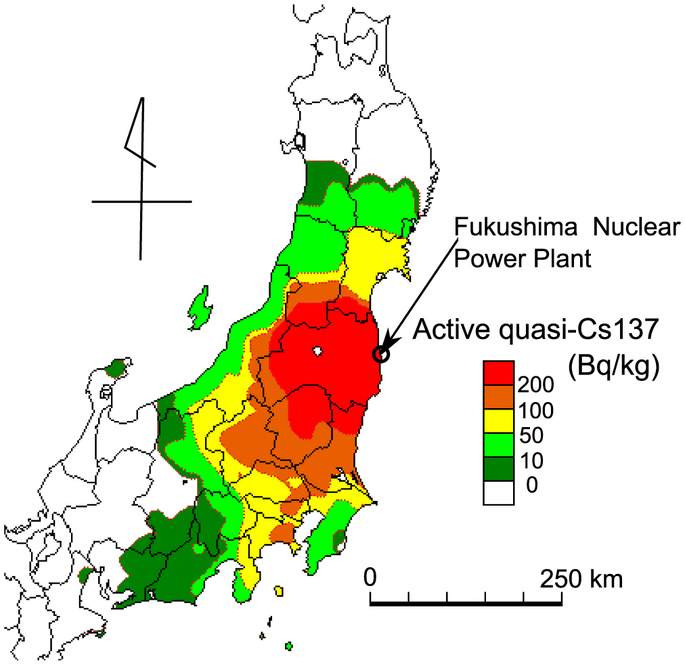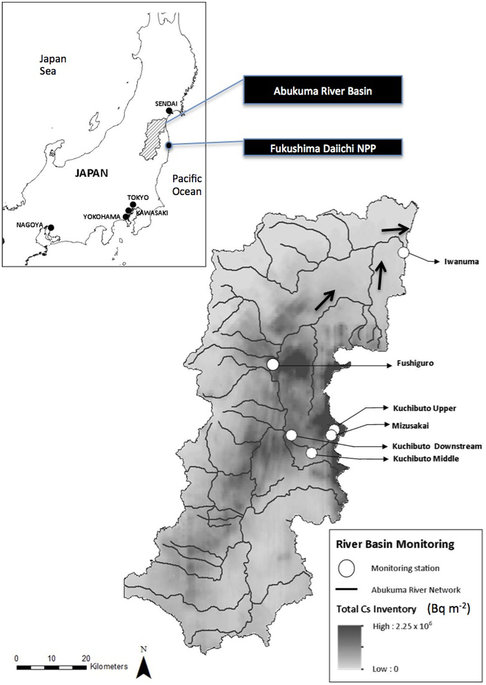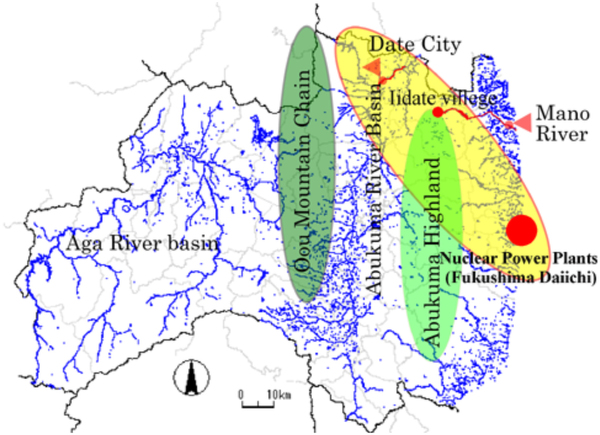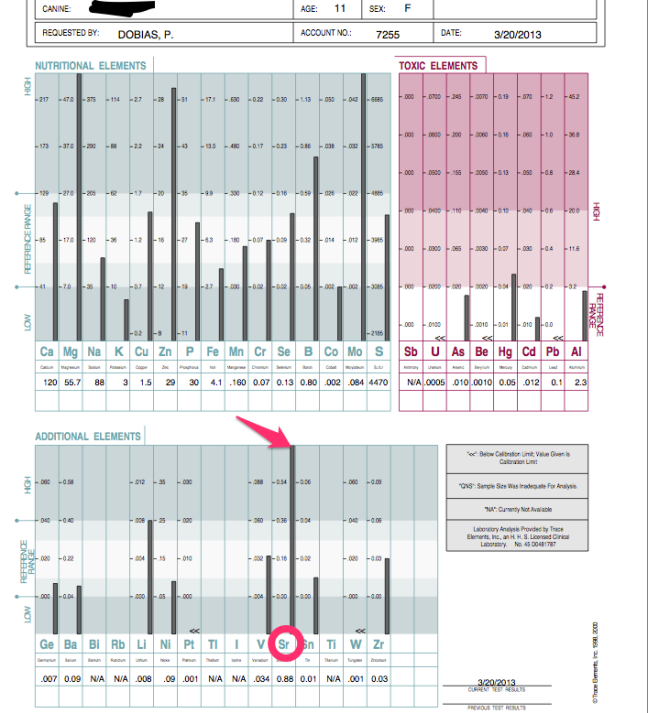
Contamination of freshwater fish is extended to all prefectures in eastern Japan.
The contamination is recognized as far as Shizuoka prefecture, 400 km south-west from the plant.
Tokyo: Japanese researchers have detected relatively high levels of radioactive substances in sediment in multiple rivers running through Fukushima prefecture, the media reported on Friday.
The prefectural government in January surveyed the density of radioactive materials in soil and other sediment that has accumulated on the bottoms and banks of 72 rivers in the prefecture, public broadcaster NHK reported.
The study came in response to the 2011 nuclear accident at the Fukushima Daiichi power plant.
The researchers found up to 54,500 becquerels per kg of radioactive substances in the Maeda river in Futaba town, where the plant is situated, and 39,600 becquerels in the Hiru river in Fukushima city.
They also detected more than 10,000 becquerels at five other locations in four municipalities.
The prefectural government plans to study restricting access to rivers with high concentrations of radioactive materials.
It also plans to urge the central government to remove contaminated soil and other sediment.
http://www.thejapannews.net/index.php/sid/242732285
The prefectural government in January surveyed the density of radioactive materials in soil and other sediment that has accumulated on the bottoms and banks of 72 rivers in the prefecture, public broadcaster NHK reported.
The study came in response to the 2011 nuclear accident at the Fukushima Daiichi power plant.
The researchers found up to 54,500 becquerels per kg of radioactive substances in the Maeda river in Futaba town, where the plant is situated, and 39,600 becquerels in the Hiru river in Fukushima city.
They also detected more than 10,000 becquerels at five other locations in four municipalities.
The prefectural government plans to study restricting access to rivers with high concentrations of radioactive materials.
It also plans to urge the central government to remove contaminated soil and other sediment.
http://www.thejapannews.net/index.php/sid/242732285
[HOW WILL ANYONE REMOVE RADIOACTIVE SEDIMENT FROM ALL THOSE RIVERS? HOW WILL THE ABE ADMINISTRATION PRETEND TO CLEAN THAT UP?]
Abstract
This paper focuses on an overview of radioactive cesium 137 (quasi-Cs137 included Cs134) contamination of freshwater fish in
Fukushima and eastern Japan based on the data published by the Fisheries
Agency of the Japanese Government in 2011. In the area north and west
of the Fukushima Nuclear plant, freshwater fish have been highly
contaminated. Abstract
For example, the mean of active cesium (quasi-Cs137) contamination of Ayu (Plecoglossus altivelis) is 2,657 Bq/kg at Mano River, 20–40 km north-west from the plant. Bioaccumulation is observed in the Agano river basin in Aizu sub-region, 70–150 km west from the plant.
The active cesium (quasi-Cs137) contamination of carnivorous Salmondae is around 2 times higher than herbivorous Ayu. The extent of active cesium (quasi-Cs137) contamination of Ayu is observed in the entire eastern Japan.
The same level of the contamination is recognized even in Shizuoka prefecture, 400 km south-west from the plant.
[AS LONG AS THE ABE GOVERNMENT DISALLOWS ANY OUTSIDE EFFORT THAT MIGHT REMOTELY BE OF HELP IN STOPPING THIS DAILY CONTAMINATION AND AS LONG AS THE NEED TO HIDE AND SUPPRESS TRUTHFUL DATA THAT MIGHT GO AGAINST THEM IN COURTS KEEPS TEPCO FROM BEING HONEST WITH ALL OF US, THE POLLUTION OF JAPAN'S RIVERS WILL CONTINUE, AS WILL THE KILLING OF THE PACIFIC OCEAN...AND UNTOLD NUMBERS OF MARINE AND LAND ANIMALS...AND HUMAN BEINGS ON A GRAND, A GLOBAL SCALE NEVER SEEN BEFORE IN HISTORY.
IT IS A CRIME AGAINST HUMANITY!
IT IS A CRIME AGAINST ALL LIFE ALL OVER THIS GLOBE!]
PROOF OF CONTINUED STRONTIUM DANGER FROM JAPAN BY, OF ALL THINGS, A VETERINARIAN!
Dogs fed sardines show high Strontium levels
by Dr. Peter Dobias, DVM
Why you might want to cut out small fish from your dog’s diet
I have had two dog patients with severely elevated levels of the element strontium. The interesting part is that these two dogs were fed a high amount of sardines and I highly suspect that strontium is coming from this source.
Strontium acts in the body the same way as calcium and deposits in bones.
Sardines and other small fish are eaten whole with the bones and that is why they are more likely a source of this toxic element.
The reason why I am concerned is that the radioactive isotope strontium 90 is a toxic carcinogen and it has been released in Japan’s Fukushima disaster.
Here is an example of the results:
http://peterdobias.com/blogs/blog/11014105-dogs-fed-sardines-show-high-strontium-levels
AND IN A RELATED ARTICLE FROM FUKUSHIMA DIARY...
"The reason why Tepco doesn’t analyze fishery products for Strontium-90 is only because it’s the rule. Tepco stated in the press conference of 2/19/2014.
Having highly contaminated water leaking to the sea, the biological concentration of marine products is one of the most important issues.
However, they don’t analyze the samples for Strontium-90, which is accumulated in bone to cause human consumers leukemia.
Like ordinary food test of the government, they only analyze them for Cesium-134/137.
Among tens of the test results, they release Strontium-90 data only about a couple of the samples, once in a few months.
Tepco doesn’t have the plan to analyze the samples for Strontium-90 and other nuclides more frequently, and the reason to refuse the proposal wasn’t announced either."
http://www.nuc.berkeley.edu/node/3007
"It has been reported that Strontium has been detected in other countries as well but this is the first confirmation that it has been found that I could find outside the grounds of the Daichi plant (meaning it must have been in the initial blasts and/or gas vented)
Once again the failure of ANYONE to be testing for this is really troubling."
[NOTE: THIS WAS IN 2011.]
HOW THE CONTAMINATION IS SPREAD BY EITHER ABJECT IGNORANCE OR BY INTENT...
“The Japanese government decided early on in the decontamination process that all prefectures in Japan should share the burden of storing radioactive waste with Fukushima Prefecture,” says James Whitlow Delano, who has been photographing the disaster since it happened in 2011. “This resulted in firm pushback by communities in other prefectures that are adjacent to sites that were selected.”
They have reason to be concerned: In September of 2015, when there were floods in Nikko, Japan, hundreds of bags of radioactive soil were washed into the local river.
Along the shore at JUST ONE temporary storage site at Tomioka are 10.7
million 1-ton container bags containing radioactive debris and other
waste collected in decontamination outside the plant...right next to the waterfront in a ‘Wall-E’ style.
The visual representation of the failure of this nuclear power plant is shocking.
HERE ARE THE NUMBERS:
49: Municipalities in [ONLY] Fukushima that have completed decontamination work.
45: Number that have not.
760,000: Metric tons of contaminated water currently stored at the Fukushima nuclear plant.
1,000: Tanks at the plant storing radioactive water after treatment.
[TEPCO HAS NO CLUE HOW MANY OF THESE TEMPORARY TANKS ARE LEAKING AFTER 5 LONG YEARS OF HEAVY RADIATION DAMAGING THEIR STRUCTURE!]
7,000: Workers decommissioning the Fukushima plant.
26,000: Laborers on decontamination work offsite.
The visual representation of the failure of this nuclear power plant is shocking.
HERE ARE THE NUMBERS:
49: Municipalities in [ONLY] Fukushima that have completed decontamination work.
45: Number that have not.
760,000: Metric tons of contaminated water currently stored at the Fukushima nuclear plant.
1,000: Tanks at the plant storing radioactive water after treatment.
[TEPCO HAS NO CLUE HOW MANY OF THESE TEMPORARY TANKS ARE LEAKING AFTER 5 LONG YEARS OF HEAVY RADIATION DAMAGING THEIR STRUCTURE!]
7,000: Workers decommissioning the Fukushima plant.
26,000: Laborers on decontamination work offsite.
OTHER STORAGE SITES LIE ALONG YET OTHER RIVERS AND STREAMS, THOUSANDS OF UNGUARDED CRUMBLING PLASTIC BAGS EXPOSED NOT ONLY TO THE ELEMENTS BUT ALSO TO THE RADIATION INSIDE THEM.
JAPAN PLANS TO USE THIS MEANS OF "TEMPORARY STORAGE" FOR 30 YEARS, MINIMUM!
30 YEARS OF TYPHOONS, MONSOONS, AND WITHOUT CONSIDERATION OF EVERY POSSIBLE ACCIDENT THAT CAN BEFALL STACKS AND STACKS OF UNSECURED PLASTIC BAGS...FROM PERHAPS CHILDISH VANDALISM TO DELIBERATE USE OF THESE RADIOACTIVE BAGS BY ANY TERRORISTS INTERESTED IN USING THEM AS WEAPONS AGAINST LOCAL POPULATIONS, TO QUIETLY AND WITHOUT BEING NOTICED, TURN THESE PILES OF RADIOACTIVE WASTE INTO ENVIRONMENTAL CATASTROPHES FOR UNSUSPECTING CITIZENS WHO DEPEND ON LOCAL WATER SOURCES FOR DRINKING, COOKING, BATHING.
As of 2015, the government reported that there were more than 9 million bags in the Fukushima prefecture.
Some of it will be moved inside the no-entry zone next to the nuclear plant, which is so radioactive that the government has given up on decontamination for the moment. But Japan is also sending radioactive waste to other parts of the country.
“People fear the presence of this soil and the dust that every breeze will carry into their neighborhood,” Japan-based photographer James Whitlow Delano says. “It creates fear and doubt.
Many families, especially those with young children, are not returning to this region of Fukushima Prefecture.”
[Every breeze also carries that aloft, but there's still plenty fallout from the Daiichi facility. Contamination by that leaking monster will go on for at least another 30 to 40 years, longer if no one can come up with "new technology" to begin its cleanup, a way to stop all the leaks all the time.]
ABOUT THE DECONTAMINATION WORKERS....
MINAMISOMA, Japan — The ashes of half a dozen unidentified laborers ended up at a Buddhist temple in this town just north of the crippled Fukushima nuclear plant.
Some of the dead men had no papers, others left no emergency contacts.
Their names could not be confirmed and no family members had been tracked down to claim their remains.
They were simply labeled “decontamination troops” — unknown soldiers in Japan’s massive cleanup campaign to make Fukushima livable again five years after radiation poisoned the fertile countryside.
The men were among the 26,000 workers — many in their 50s and 60s from the margins of society with no special skills or close family ties — tasked with removing the contaminated topsoil and stuffing it into tens of thousands of black bags lining the fields and roads.
They wipe off roofs, clean out gutters and chop down trees in a seemingly endless routine.
Coming from across Japan to do a dirty, risky and undesirable job, the workers make up the very bottom of the nation’s murky, caste-like subcontractor system long criticized for labor violations.
Vulnerable to exploitation and shunned by local residents, they typically work on three-to-six-month contracts with little or no benefits, living in makeshift company barracks.
And the government is not even making sure that their radiation levels are individually tested.
“They’re cleaning up radiation in Fukushima, doing sometimes unsafe work, and yet they can’t be proud of what they do or even considered legitimate workers,” said Mitsuo Nakamura, a former day laborer who now heads a citizens’ group supporting decontamination laborers.
“They are exploited by the vested interests that have grown in the massive project.”
Residents of still partly deserted towns such as Minamisoma, where 8,000 laborers are based, worry that neighborhoods have turned into workers’ ghettos with deteriorating safety.
Police data shows arrests among laborers since 2011 have climbed steadily from just one to 210 last year, including a dozen yakuza, or gangsters, police official Katsuhiko Ishida told a prefectural assembly.
Residents are spooked by rumors that some laborers sport tattoos linked with yakuza, and by reports that a suspect in serial killings arrested in Osaka last year had worked in the area.
“Their massive presence has simply intimidated residents,” said Mayor Katsunobu Sakurai. “Frankly, the residents need their help but don’t want any trouble.”
Most of the men work for small subcontractors that are many layers beneath the few giants at the top of the construction food chain. Major projects such as this one are divided up among contractors, which then subcontract jobs to smaller outfits, some of which have dubious records.
The Ministry of Health, Labor and Welfare examined more than 300 companies doing Fukushima decontamination work and found that nearly 70 committed violations in the first half of last year, including underpayment of wages and overtime and failure to do compulsory radiation checks.
Those companies were randomly chosen among thousands believed to be working in the area.
THOUSANDS!
“Violations are so widespread in this multilayer subcontract system. It’s like a whack-a-mole situation,” said Mitsuaki Karino, a city assemblyman in Iwaki, a Fukushima city where his civil group has helped workers with complaints about employers.
Karino said workers are sometimes charged for meals or housing they were told would be free, he said, and if they lose jobs or contracts aren’t renewed, some go homeless.
“It’s a serious concern, particularly for workers who don’t have families or lost ties with them,” he said.
Government officials say they see no other way than to depend on the contracting system to clean up the radiated zone, a project whose ballooning cost is now estimated at 5 trillion yen ($44 billion).
“That’s how the construction industry has long operated. In order to accomplish decontamination, we need to rely on the practice,” said Tadashi Mouri, a health and labor ministry official in charge of nuclear workers’ health.
He said the ministry has instructed top contractors to improve oversight of subcontractors.
THE ABE ADMINISTRATION STILL TRYING TO HIDE THE TRUTH?
Government officials keep close tabs on journalists.
Minutes after chatting with some workers in Minamisoma, Associated Press journalists received a call from a city official warning them not to talk to decontamination crews.
[NEED WE WONDER WHY?]
Beyond the work’s arduous nature, the men also face radiation exposure risks.
Inhaling radioactive particles could trigger lung cancer, said Junji Kato, a doctor who provides health checks for some workers.
Although most laborers working in residential areas use protective gear, others in remote areas are not monitored closely, according to workers and Nakamura, the leader of the radiation workers support group.
Many are not given compulsory training or education about dealing with radiation, he said.
One resident grateful for the workers is Hideaki Kinoshita, a Buddhist monk who keeps the unidentified laborers’ ashes at his temple, in wooden boxes and wrapped in white cloth.
“We owe a lot to those who clean this town, doing the work that locals don’t even want to,” he said.
Minamisoma city official Tomoyuki Ohwada said the worker population should decline next year, when intensive decontamination efforts are scheduled to end.
But Kinoshita believes many will still be needed, given the amount of work left to do.
“There is no end to this job,” Kinoshita said. “Five years from now, the workers will still be around. And more unclaimed ashes may end up here.”
___________________________________
OF INTEREST...
1~Call on nuclear nations NOT to dump nuclear waste in Australia. http://www.anfa.org.au/sign-the-declaration/
The Australian Nuclear Free Alliance, representing Aboriginal people from across Australia, calls on nuclear nations NOT to dump nuclear waste in Australia. The nuclear industry has a track record of Aboriginal dispossession and environmental pollution − from the atomic bomb tests to uranium mining to nuclear waste dump proposals
2~PETITION. George Osborne: Don’t Waste £Billions On Nuclear Power
https://secure.greenpeace.org.uk/page/s/osborne-dont-waste-billions-nuclear?source=em&subsource=20160307egem01&utm_source=gpeace&utm_medium=em&utm_campaign=20160307egem01
26th of April appeal
For an artistic, intellectual, scientific and people’s insurrection
against the pursuit of radioactive contamination of the planet http://www.brut-de-beton.net/
3~ CLEAN UP TOXIC ABANDONED URANIUM MINES!
PETITION http://diy.rootsaction.org/petitions/clean-up-15-000-toxic-abandoned-uranium-mines?bucket=&source=twitter-share-button
4~ UNAOIL – The Company That Bribed The World
HuffPost http://www.theage.com.au/interactive/2016/the-bribe-factory/day-1/the-company-that-bribed-the-world.html 31 Mar 2016
"
A massive leak of confidential documents has for the first time exposed the true extent of corruption within the oil industry, implicating dozens of leading companies, bureaucrats and politicians in a sophisticated global web of bribery and graft.
After a six-month investigation across two continents, Fairfax Media andThe Huffington Post can reveal that billions of dollars of government contracts were awarded as the direct result of bribes paid on behalf of firms including British icon Rolls-Royce, US giant Halliburton, Australia’s Leighton Holdings and Korean heavyweights Samsung and Hyundai."
http://www.theage.com.au/business/police-raids-and-more-revelations-the-fallout-of-the-unaoil-scandal-20160401-gnw9mx.html#ixzz44ZNjGbWg





No comments:
Post a Comment